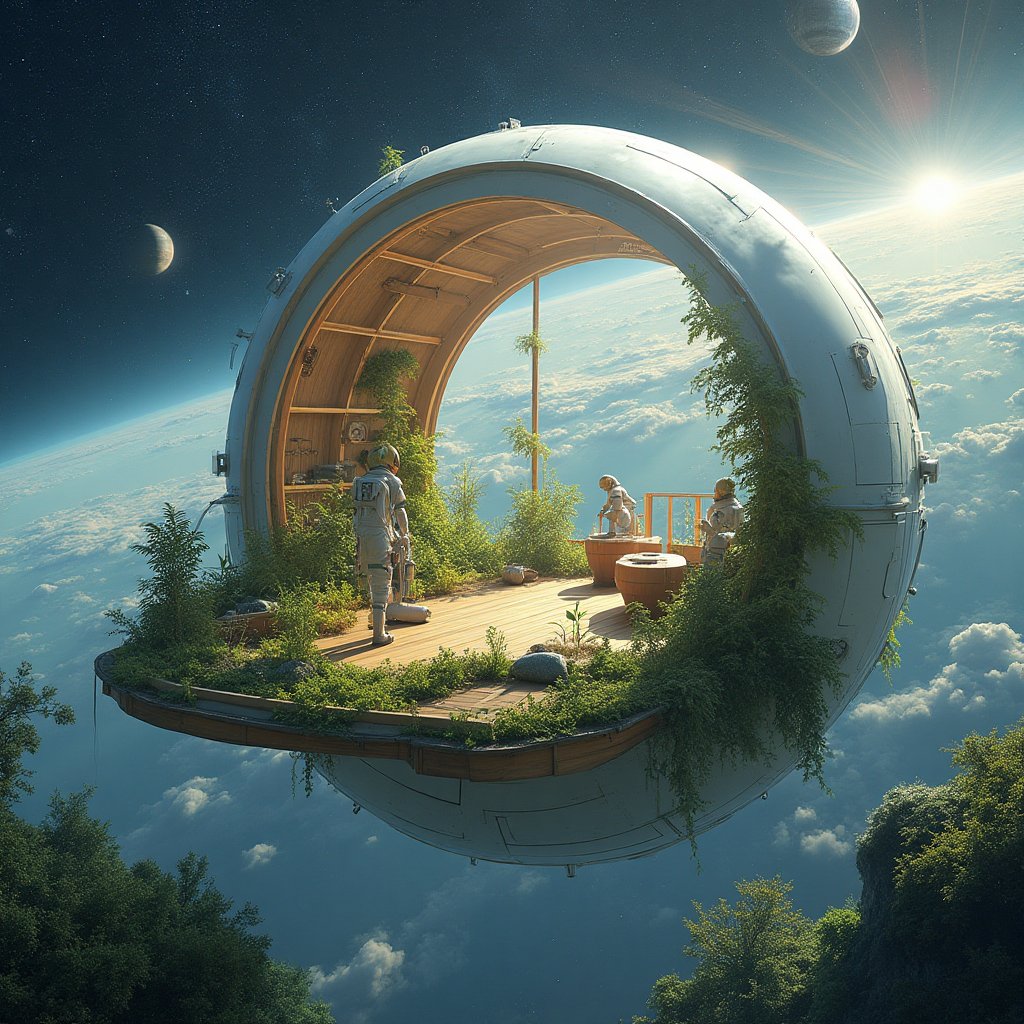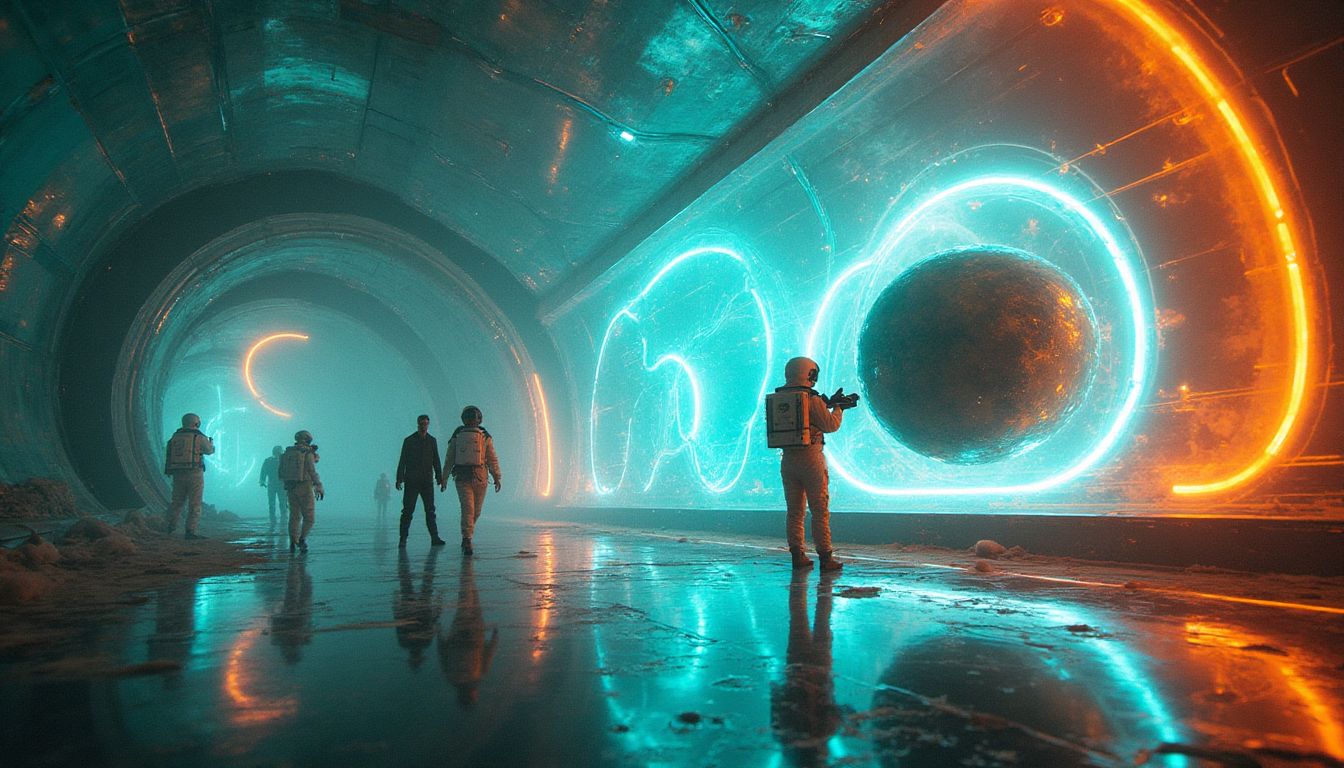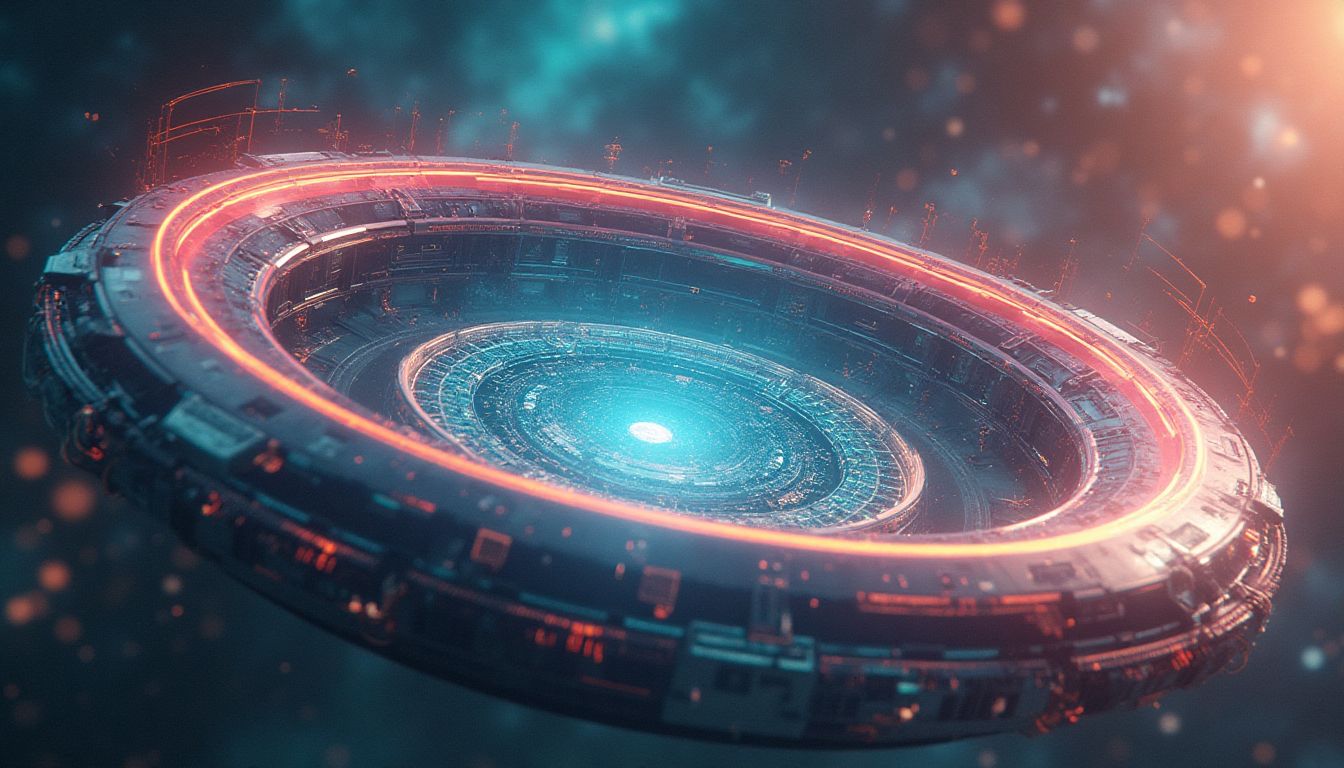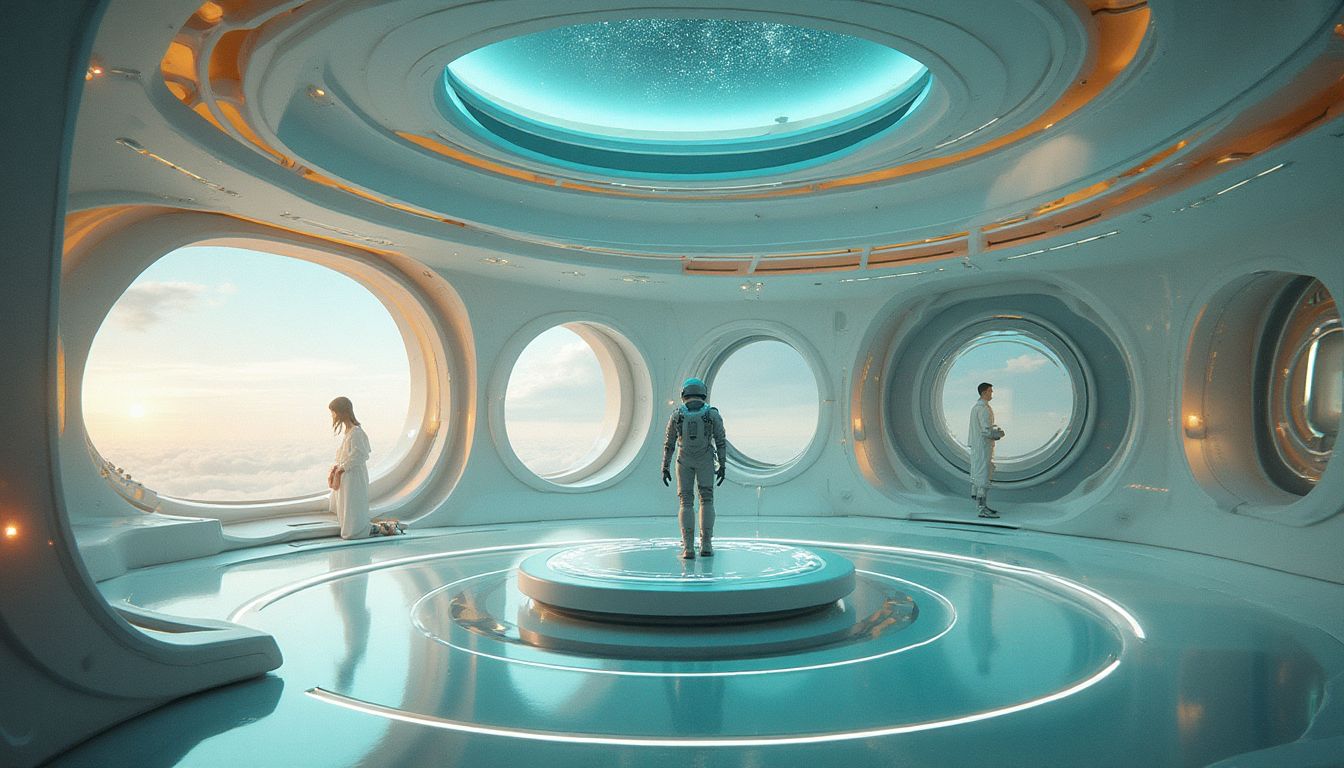Introduction: The Future of Living in Space
We are not makers of history. We are made by history. — Martin Luther King Jr. This quote captures the essence of our journey into space, where the foundations we lay today will shape our future and possibly redefine human existence. As we look to the heavens, new challenges emerge. Can we make the cold, infinite abyss of space feel like the cozy confines of our blue planet? This isn't just an episode of Star Trek; it's the real quest with Artificial Gravity Generators (AGGs) and Artificial Intelligence (AI) as our guides.
Now, before you get swept away by visions of spacecraft zooming past at light speed, let's unpack this. The vacuum of space presents a peculiar problem: the absence of gravity. While zero gravity might sound like a fun, floaty fantasy, in reality, it is less about freedom and more about little gremlins wreaking havoc on our bodies. Without gravity, our bones weaken, muscles shrink, and let’s not even start on the mental gymnastics required to stay sane. Thankfully, AGGs, with the help of AI, are here to save the day and perhaps send us all rushing toward our very own space odyssey!
The Science Behind Gravity Simulation
At the heart of gravity simulation lies one of our universe's most alluring mysteries: how do we recreate Earth's pull in space? Let's embark on this journey, trekking through the shimmering lanes of science where revered minds like Isaac Newton meet the genius of Albert Einstein.
Centrifugal Force: The Basic Mechanism
Picture this: you're on a merry-go-round spinning lazily under a summer sun. That gentle push you feel—pretending to keep you on your seat—is much like what scientists aim to achieve with centrifugal force in space. By spinning a spacecraft or habitat, we can trick our lovely human senses into feeling a pull toward the floor, akin to the comforting hug of our planet's gravity. Isn’t it amusing that something as simple as spinning could help us transcend the daunting challenges of space living?
In fact, the science here parallels Einstein's theory of general relativity, where gravity is not a force in the traditional sense but rather a curvature in the fabric of space-time. Using rotation, we can mimic this experience, all the while sending astronauts into a spin—literally.
Linear Acceleration: Another Approach
But wait, there’s more! Say hello to linear acceleration. Imagine the power of a drag car rocketing forward—the force pushing you back into your seat could also create a gravity-like effect in space. Now, some might argue it requires a spacecraft that never stops accelerating, but let's channel our inner Dr. Robert Forward, an innovative aerospace engineer, in dreaming of what innovations might declare this possible tomorrow.
Researchers around the world, including the likes of Dr. John Paul, are exploring these thrilling avenues, combining Austrian painter Gustav Klimt’s chaos of garbled spirals with structured symmetry from a Chief Technologist's spreadsheet to bring AGGs to life.
2. Psychological and Physiological Effects of Microgravity
Imagine floating like a feather, untethered and free. Sounds dreamy, right? But living in microgravity is more akin to spending a week in grandma's refrigerator than a sleek sci-fi film. It turns out space is not just about weightlessness and cool spacewalks; our bodies pay a hefty price. Microgravity is a tricky fiend, whispering mischief into the very fabric of our muscles and bones.
2.1 Muscle and Bone Health
Picture yourself lounging on a couch for months. Muscles atrophy, bones become as brittle as grandma's china, and your stamina? Kaput. That's what happens to astronauts zipping around in space. According to a study in the Journal of Bone and Mineral Research, astronauts can lose up to 1% of bone mass per month in microgravity. A similar fate befalls their muscles, leading to deconditioning. Imagine astronauts returning to Earth, where even a grocery bag feels like Thor's hammer!
2.2 Mental and Emotional Health
Space might be the final frontier, but isolation and anxiety are its annoying travel companions. Down here, we have our circle of friends, the reassuring murmur of city life, and the odd cup of joe to boost our spirits. Up there, however, it's a different ball game. Astronauts experience a unique form of cabin fever, wrapped in a tin can miles above the Earth. NASA's research shows that extended space missions can lead to psychological concerns like anxiety and depression. Space might look like an adventure, but it can also take you on an unexpected emotional rollercoaster!
3. Technological Innovations in AI-Driven Gravity Solutions
Now, let's take a deep dive into the cool tech waters of Artificial Intelligence (AI). If microgravity is the villain in our space saga, AI might just be the charming hero with a knack for solving complex equations. AI isn't just about showing off self-driving cars or weirdly human-like robots; it holds the key to designing the perfect space abode, where spacefarers can feel right at home.
3.1 Machine Learning and Data Modeling
With every bleep and flash, machine learning algorithms are constantly refining the art of analyzing data. Imagine AI as your personal detective, snooping through terabytes of data to understand how your body likes its artificial gravity. These intelligent algorithms are capable of optimizing gravity generation based on YOUR needs. According to a piece in Forbes, AI can create environments tailored for individual well-being. Take that, Zero-G!
3.2 Smart Habitat Design
AI-driven smart habitats are not just a sci-fi lover’s utopia. They're becoming a reality, one algorithm at a time. Imagine dwelling in a habitat that adjusts its gravity just as you adjust your thermostat. That's the stuff of space-age magic! AI can craft habitats that don't just mimic Earth's gravitational hug but enhance astronaut comfort and mental health. As NASA scientists experiment with these possibilities, AI is the artist painting over the empty canvas of space living.
4. Current Projects and Research in Artificial Gravity
As the world collectively dreams of exploring the universe, artificial gravity is becoming a focal point of research. Various space agencies and academic institutions are diving headfirst into this ambitious endeavor. Their goal? To make space habitats as comfortable and sustainable as possible, bridging the gap between science fiction and reality. Let's plunge into the riveting universe of current projects and collaborations poised to redefine human life in space.
4.1 NASA and the Artemis Program
NASA’s Artemis Program - a beacon of hope for lunar exploration - is pioneering efforts in developing artificial gravity solutions. Their initiatives emphasize creating conditions conducive for longer missions, particularly those aiming toward the Moon and eventually Mars. Artemis aims not only to visit these celestial neighbors but also to thrive using artificial gravity technologies to ensure astronaut health and safety during extended stays.
4.2 International Collaborative Efforts
Across the globe, countries and organizations are coming together, pooling resources and knowledge to push the boundaries of what’s possible in space habitation. Among notable partnerships are collaborations such as:
- European Space Agency (ESA) teaming up with Japan Aerospace Exploration Agency (JAXA) to explore centrifuge-based artificial gravity modules.
- Indian Space Research Organisation (ISRO) collaborating with leading universities to simulate gravity using innovative rotational systems.
These international cooperative efforts exemplify the value of shared visions in overcoming the daunting challenges of living in space.
5. The Ethics and Future of Artificial Gravity Technology
Venturing into the vacuum of space, humanity encounters not just technical hurdles but ethical ones too. Artificial gravity technology, while promising, opens a Pandora's box of moral quandaries. This section delves into the ethical terrain, exploring both the challenges and the path forward as we grapple with profound questions about technology and humanity.
5.1 Ethical Challenges
The very prospect of artificial gravity raises pressing ethical questions. Considerations such as:
- Equity: Who has access to life-sustaining technology in space?
- Privacy: Can we ensure individual privacy when relying on AI systems?
- Dependency: How do we balance technological reliance with human autonomy?
These are vital questions explored in ongoing debates, influencing policy and guiding principles for fair and just implementation of AI in space habitats.
5.2 Future Perspectives: AI and Humanity
The future intertwines AI deeply with the human experience, potentially altering how we perceive life outside our Earthly cradle. As we push forward, nurturing these AI-driven environments, we shape our own evolution. Will the comforts of simulated gravity redefine human existence? As Isaac Asimov once pondered, “The saddest aspect of life right now is that science gathers knowledge faster than society gathers wisdom.” Our challenge is to harness technology while anchoring firmly to ethical standards and humanity's deeper values.
AI Solutions: How Would AI Tackle This Issue?
To address the challenge of creating artificial gravity, AI would implement data analysis, simulation modeling, and operational management strategies. Through iterative learning and adapting to an astronaut’s physiological responses, AI would optimize simulated gravity conditions.
Step 1: Data Collection and Analysis
Use advanced AI algorithms to collect and interpret comprehensive biometric data from astronauts to inform design parameters. Machine learning can be deployed to track the diverse health metrics of astronauts, including heart rates, muscle mass, and psychological states, which would be continuously monitored through cutting-edge wearable technology. This data will help craft personal adjustments to artificial gravity settings, ensuring each astronaut’s unique needs are met. Organizations like NASA and SpaceX can provide insights into existing monitoring technologies.
Step 2: Development of Simulations
Create virtual environments using AI to simulate various gravity scenarios, allowing researchers to experiment and gather data safely. Digital twins of spacecraft can be used to recreate real-time simulations where different artificial gravity conditions are tested. This method not only ensures a risk-free environment for testing but also allows variations in gravitational effects to be quickly analyzed. Companies like SimScale specialize in virtual simulation tools that can aid these experiments.
Step 3: Adaptive Mechanisms
Utilizing AI to develop adaptive platforms that can respond in real-time to the health and comfort needs of astronauts. By combining biometric data analysis and machine learning, AI can dynamically adjust the artificial gravity environments to cater to the individual well-being of astronauts, helping alleviate physical discomfort and mental strain, which can be crucial during long missions. Platforms like ResearchGate provide valuable research insights into adaptive systems.
Step 4: User-Centric Design Feedback
AI would seek constant feedback to refine habitat requirements further, ensuring optimal conditions. Astronauts could participate in regular surveys and biometric feedback sessions to communicate their experiences, forming an iterative loop of design and adjustment. This feedback must be facilitated through intuitive interfaces to guarantee maximum participation and quality data collection. Collaborating with user experience design teams could enhance the process, much like Nielsen approaches user experience and feedback collection.
Conclusion: Bringing Space Closer to Home
Artificial gravity generators offer a glimpse into the future of human habitation in space, where advanced technology converges with biology to mitigate the challenges posed by microgravity. As we venture further into the universe, AI’s role remains pivotal in transforming sterile environments into nurturing habitats that echo the comforts of Earth, thereby redefining human existence and experience beyond our planet. With effective artificial gravity, we can imagine a future of thriving in space. Human beings, who currently dread the thought of long-term space missions due to health concerns, may find themselves on the thrilling edge of exploration, truly feeling at home among the stars.
Implementing real solutions involves a dedicated roadmap that weaves through innovation and accountability, fostering collaboration among international agencies and private industry leaders. From the first day of project initiation to full deployment within a two-year window, organizations should focus on the below actions.
Actions Schedule/Roadmap (Day 1 to Year 2)
Day 1: Project Kick-off
Initiate project collaboration with key stakeholders, including scientists, engineers, ethicists, and space agencies. Schedule workshops to align goals and identify potential challenges, employing techniques from the Center for Military Innovation for rapid collaborative strategies.
Day 2: Data Acquisition Setup
Begin construction of data acquisition systems and wearable health monitors to allow real-time monitoring of astronauts' health metrics.
Day 3: Initial Experiments
Conduct initial experiments focusing on centrifugal forces and how they impact physical health. Early results will guide further investigations.
Week 1: Collaboration with AI Experts
Engage AI specialists to discuss modeling techniques, sharing insights from organizations like IBM Watson for cutting-edge methodologies in developing adaptive AI systems.
Month 1: Prototype Development
Develop the first prototype of an artificial gravity generator based on findings so far. Run simulations to validate design approaches and make necessary adjustments.
Year 1: Full System Testing
Conduct comprehensive testing of developed AGGs, iterating design based on data gathered from simulated environments, and employing robust testing feedback strategies.
Year 1.5: Data Analysis and Adjustments
Analyze the collected data for health impacts and functionality before finalizing designs, utilizing predictive algorithms to anticipate issues.
Year 2: Final Development Phase
Roll out the final version of AGGs for human testing and begin astronaut training programs. Facilitate feedback loops based on real-world usage for subsequent adjustments. Aim to prepare astronauts to use AGGs during civilian missions planned by the European Space Agency and other partners.
Frequently Asked Questions (FAQ)
What is artificial gravity?
Artificial gravity is a way to create the feeling of gravity in places where there isn’t any, like in a spaceship. When we go to space, there is very little gravity, so astronauts float around. Artificial gravity helps make them feel more like they're on Earth. For example, scientists can use things like spinning spaceships to mimic gravity. This helps astronauts stay healthier and feel better while in space.
How does AI contribute to artificial gravity technology?
Artificial intelligence (AI) plays a big role in making artificial gravity systems. Here are a few ways AI helps:
- Data Analysis: AI can collect and analyze health data from astronauts to help design better living conditions.
- Simulations: AI helps create tests and simulations to see how different gravity levels affect people.
- Adaptive Systems: AI systems can change conditions in the habitat based on real-time health needs, making them more comfortable.
What are the health impacts of microgravity?
Microgravity can cause a variety of health problems for astronauts during long space missions. Some effects include:
- Muscle Atrophy: Muscles can weaken because they're not working as hard without the pull of gravity.
- Bone Density Loss: Bones can become weaker and more brittle without gravity acting on them.
- Psychological Effects: Isolation and less physical activity can lead to feelings of depression and anxiety.
Are there current projects focused on artificial gravity?
Yes! Many organizations, including NASA, are researching artificial gravity. Projects like the Artemis Program aim to explore the Moon and beyond, focusing on technologies that will help astronauts live comfortably in space. Other companies and universities are also working on this exciting technology!
What ethical considerations exist in the deployment of AI in space habitats?
Using AI in space habitats brings up important ethical questions, such as:
- Privacy: How do we protect the personal data of astronauts monitored by AI systems?
- Equality: Will everyone have equal access to these advanced technologies?
- Dependence on Technology: How reliant should we be on AI to keep us safe and healthy in space?
Can artificial gravity help long-term space travel?
Absolutely! Artificial gravity can greatly improve life for astronauts on long missions. By providing a more Earth-like environment, artificial gravity can help combat health issues caused by microgravity. It can also make life in space more comfortable and enjoyable by reducing stress and improving mental health.
What future technologies could enhance artificial gravity systems?
Looking ahead, there are many exciting technologies that could improve artificial gravity:
- Advanced AI Algorithms: Better algorithms might optimize gravity settings based on astronauts' needs.
- Smart Wearables: For monitoring health in real-time, wearables can help AI adjust conditions.
- 3D Printing: Used to create customized equipment and environments to improve astronauts' comfort.
How does centrifugal force work to create artificial gravity?
Centrifugal force is a way to create artificial gravity by spinning. When a spacecraft or a habitat spins, objects push outward due to the rotation, creating a sensation similar to gravity. The faster something spins, the stronger the force felt by people inside. It’s like when you ride a merry-go-round—the faster it spins, the more you feel pushed outward!
What are the challenges in developing artificial gravity?
Developing artificial gravity isn’t easy. Some challenges include:
- Engineering Limits: Creating designs that can effectively simulate gravity without risking structural integrity.
- Health Monitoring: Creating systems that can adapt in real-time to maintain the health and safety of astronauts.
- Cost: Funding for research and development can be a significant hurdle.
Wait! There's more...check out our gripping short story that continues the journey: The Veil
Disclaimer: This article may contain affiliate links. If you click on these links and make a purchase, we may receive a commission at no additional cost to you. Our recommendations and reviews are always independent and objective, aiming to provide you with the best information and resources.
Get Exclusive Stories, Photos, Art & Offers - Subscribe Today!





























1 comment